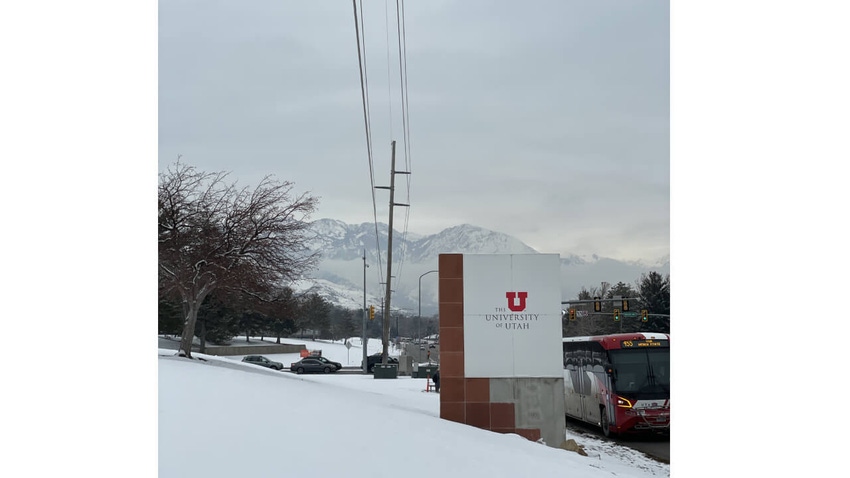
In snowy Salt Lake City, a city-sized 5G network is humming along with hundreds of devices connected to dozens of endpoints, measuring every imaginable thing you can in a modern cellular network.
Researchers and industry experts here are digging deep into spectrum sharing, O-RAN controlled RAN slicing, 5G edge computing, RF propagation models and more. If you're well-versed in the world of 4G, 5G and edge computing, the dozens of projects happening in the POWDER testbed at the University of Utah will give you plenty to think about and read about.
The POWDER testbed has been around a few years – we covered it before the paint was dry – but the latest developments have made the resource all the more valuable to the executives from T-Mobile, AT&T and a variety of telecom vendors that we met attending a hosted day-long conference last month.
Light Reading took a few minutes from the conference to speak with Kobus Van der Merwe, a professor at the University of Utah's School of Computing and the director of the POWDER testbed. And, yes, we asked him if the telecom industry's fight with the airlines could have been avoided with some kind of real-world 5G testing.
Here's the audio of that interview:
{videoembed|783010}
One new development during our campus tour is that the POWDER testbed is now open source – it's an end-to-end network that allows for experimentation on the RAN and parts of the network's core and the services that run inside. Second, there are experiments with open RAN and spectrum sharing happening here, and the majority of the focus of researchers is looking beyond 5G.
Figure 8:  The POWDER testbed has three Massive MIMO antennas on rooftops around campus and at least nine different rooftop base station antennas in various locations.
The POWDER testbed has three Massive MIMO antennas on rooftops around campus and at least nine different rooftop base station antennas in various locations.
(Source: Phil Harvey|Light Reading)
The POWDER (Platform for Open Wireless Data-driven Experimental Research) testbed is "one of the only testbeds in the country with an outdoor, over-the-air, fully programmable 5G network," according to US Ignite's Mari Silbey, the program director for PAWR (the Platforms for Advanced Wireless Research).
PAWR, which just announced some fresh funding in December, is a public-private partnership funded by the National Science Foundation (NSF) and a 30-company industry consortium; US Ignite and Northeastern University manage it.
Silbey adds that the importance of the POWDER testbed is its relative neutrality in a competitive tech sector and that every part of the testbed is available functionally as a kind of lab-as-a-service. "It is remotely accessible and offers an invaluable resource to researchers across the academic, government, and private sectors," she said.
Figure 1:  One of the compute nodes used for over-the-air experiments at the University of Utah. This one is similar to the nodes used on campus shuttles, which you can watch on a live map here. The POWDER platform allows for remote access to a full range of 5G experiments.
One of the compute nodes used for over-the-air experiments at the University of Utah. This one is similar to the nodes used on campus shuttles, which you can watch on a live map here. The POWDER platform allows for remote access to a full range of 5G experiments.
(Source: Phil Harvey|Light Reading)
Figure 5:  POWDER rooftop antennas spotted on the University of Utah's Joseph F. Merrill Engineering Building.
POWDER rooftop antennas spotted on the University of Utah's Joseph F. Merrill Engineering Building.
(Source: Phil Harvey|Light Reading)
Figure 4:  During a walking tour of the POWDER testbed, Alex Orange, Research Associate, School Of Computing, shows the group one of the 10 fixed endpoints around campus that are used in a wide variety of outdoor over-the-air experiments.
During a walking tour of the POWDER testbed, Alex Orange, Research Associate, School Of Computing, shows the group one of the 10 fixed endpoints around campus that are used in a wide variety of outdoor over-the-air experiments.
(Source: Phil Harvey|Light Reading)
Figure 9:  Inside what looks like a light pole on campus sits a dense deployment node. These outdoor radios in the testbed are located closer together than the rooftop radios, allowing for experiments with stronger signals and higher frequencies.
Inside what looks like a light pole on campus sits a dense deployment node. These outdoor radios in the testbed are located closer together than the rooftop radios, allowing for experiments with stronger signals and higher frequencies.
(Source: Phil Harvey|Light Reading)
Figure 12:  Here's a view of the same 'light pole' antenna from the sidewalk, just as the tour group arrived.
Here's a view of the same 'light pole' antenna from the sidewalk, just as the tour group arrived.
(Source: Phil Harvey|Light Reading)
For researchers, this place is a rare find. It has the staff and technical resources to do about anything you can imagine in a city-wide 5G network. For industry folks, the applied research and testing capabilities should be of interest, especially since, thanks to its openness, you can swap out just about any network component with your vendor equipment or software. Testing scenarios could include an indoor private 5G network or a network of outdoor radios connecting to a fleet of campus shuttles moving between steel and glass buildings.
Though no one connected the dots out loud, the US government's interest in promoting open RAN technologies and diversifying the telecom supply chain is at work here – partly by helping fund efforts like this. Both major political parties have said that the wireless market needs more domestic participants and a stronger pipeline of startups and software companies that can help the US reduce its reliance on China and other countries.
Back in 2018, testbeds like POWDER were started with the idea of building platforms that the industry and academics could use in a wide variety of ways. The faster our wireless networks evolve, the more questions proliferate and the more these investments seem more necessary than ever. As of this writing, there are 38 active experiments involving more than 1,000 users and 231 projects on the testbed.
Van der Merwe said his team has been working from day one to build a platform that could enable the broadest set of research in the wireless domain. The good news is that he's not done and the city-scale wireless testbed he started is now more open than ever.
Related links:
An open source, open RAN use case for network slicing (O-RAN Alliance)
— Phil Harvey, Editor-in-Chief, Light Reading
About the Author(s)
You May Also Like




_International_Software_Products.jpeg?width=300&auto=webp&quality=80&disable=upscale)







